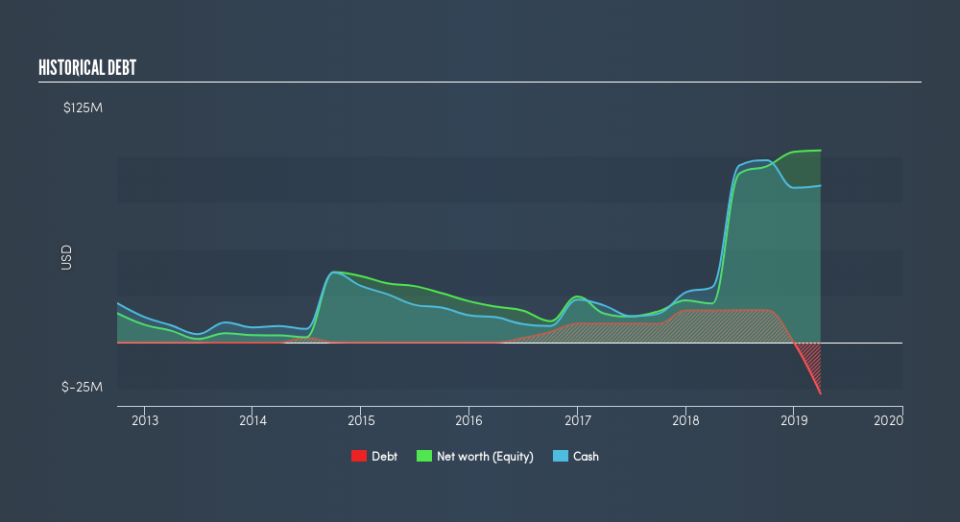Is Vericel (NASDAQ:VCEL) A Risky Investment?

Legendary fund manager Li Lu (who Charlie Munger backed) once said, 'The biggest investment risk is not the volatility of prices, but whether you will suffer a permanent loss of capital.' It's only natural to consider a company's balance sheet when you examine how risky it is, since debt is often involved when a business collapses. We can see that Vericel Corporation (NASDAQ:VCEL) does use debt in its business. But the more important question is: how much risk is that debt creating?
When Is Debt Dangerous?
Debt is a tool to help businesses grow, but if a business is incapable of paying off its lenders, then it exists at their mercy. If things get really bad, the lenders can take control of the business. While that is not too common, we often do see indebted companies permanently diluting shareholders because lenders force them to raise capital at a distressed price. Of course, the upside of debt is that it often represents cheap capital, especially when it replaces dilution in a company with the ability to reinvest at high rates of return. The first thing to do when considering how much debt a business uses is to look at its cash and debt together.
Check out our latest analysis for Vericel
How Much Debt Does Vericel Carry?
As you can see below, Vericel had US$166.0k of debt at March 2019, down from US$17.2m a year prior. However, its balance sheet shows it holds US$84.1m in cash, so it actually has US$83.9m net cash.
A Look At Vericel's Liabilities
Zooming in on the latest balance sheet data, we can see that Vericel had liabilities of US$12.9m due within 12 months and liabilities of US$25.2m due beyond that. Offsetting these obligations, it had cash of US$84.1m as well as receivables valued at US$18.8m due within 12 months. So it actually has US$64.7m more liquid assets than total liabilities.
This surplus suggests that Vericel has a conservative balance sheet, and could probably eliminate its debt without much difficulty. Simply put, the fact that Vericel has more cash than debt is arguably a good indication that it can manage its debt safely. There's no doubt that we learn most about debt from the balance sheet. But ultimately the future profitability of the business will decide if Vericel can strengthen its balance sheet over time. So if you're focused on the future you can check out this free report showing analyst profit forecasts.
Over 12 months, Vericel reported revenue of US$95m, which is a gain of 30%. With any luck the company will be able to grow its way to profitability.
So How Risky Is Vericel?
We have no doubt that loss making companies are, in general, riskier than profitable ones. And we do note that Vericel had negative earnings before interest and tax (EBIT), over the last year. And over the same period it saw negative free cash outflow of US$3.4m and booked a US$3.3m accounting loss. While this does make the company a bit risky, it's important to remember it has net cash of US$84m. That means it could keep spending at its current rate for more than five years. Vericel's revenue growth shone bright over the last year, so it may well be in a position to turn a profit in due course. By investing before those profits, shareholders take on more risk in the hope of bigger rewards. For riskier companies like Vericel I always like to keep an eye on the long term profit and revenue trends. Fortunately, you can click to see our interactive graph of its profit, revenue, and operating cashflow.
When all is said and done, sometimes its easier to focus on companies that don't even need debt. Readers can access a list of growth stocks with zero net debt 100% free, right now.
We aim to bring you long-term focused research analysis driven by fundamental data. Note that our analysis may not factor in the latest price-sensitive company announcements or qualitative material.
If you spot an error that warrants correction, please contact the editor at editorial-team@simplywallst.com. This article by Simply Wall St is general in nature. It does not constitute a recommendation to buy or sell any stock, and does not take account of your objectives, or your financial situation. Simply Wall St has no position in the stocks mentioned. Thank you for reading.

 Yahoo Finance
Yahoo Finance 
